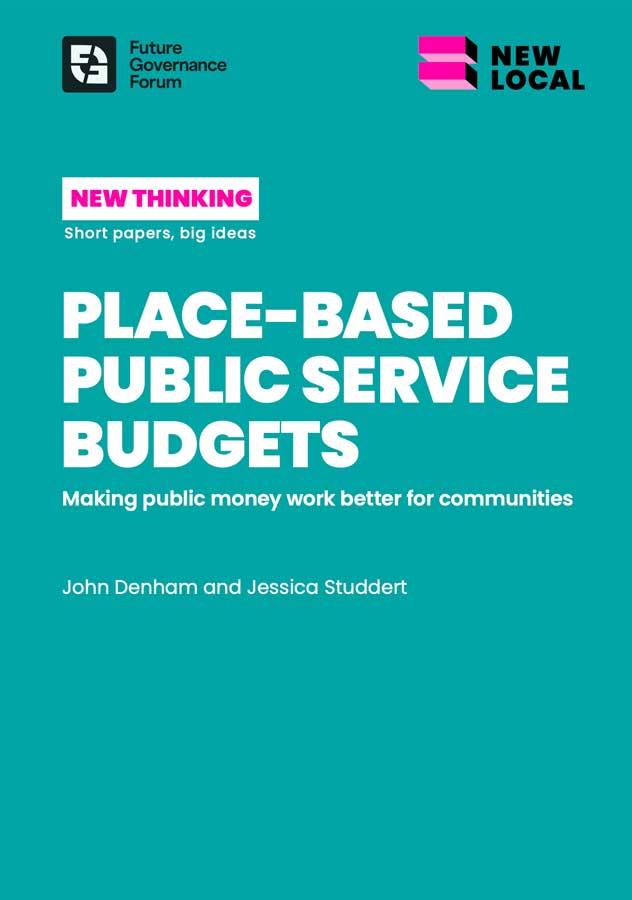Image: Istock
Place-based public service budgets
Rewiring how resource flows to meet community needs

GROWTH, REGENERATION & DEVELOPMENT

Greg Campbell
Partner, Campbell Tickell

Greg Campbell
Partner, Campbell Tickell

John Denham
Director, Centre for English Identity and Politics, Southampton University, and former Secretary of State for Communities and Local Government

Jessica Studdert
Deputy Chief Executive, New Local
Issue 73 | September 2024
With a new government, we have moved on – we trust – from ex-DLUHC Secretary of State Michael Gove’s insistence on councils producing ‘productivity plans’. After more than a decade of funding cuts, revenue raising constraints and rising demand for services, the idea there is still significant ‘wasteful expenditure’ to strip out is just not serious.
The NHS has been operating under a commitment to deliver an annual efficiency improvement of 2.2%, even though a third of integrated care systems admitted this year’s finance plans will be missed. Meanwhile the Ministry of Justice’s answer to the criminal justice system’s courts backlog was a stretch target to reduce it by 2025, already off track.
National politicians, of course, only have certain levers available, themselves subject to political and fiscal constraints. The situation facing public services is critical, but challenging public finances mean little prospect of significant new funding. Is future national public services policy to continue as an endless cycle of grandstanding and rhetorical efficiency drives?
Place-based public service budgets
A New Local report, in association with the Future Governance Forum, sets out a different approach. The starting point for more effective use of public resource overall should be places, rather than single services. From this vantage point, the inefficiencies too often priced into our dominant Whitehall model of provision are apparent.
Many people have direct experience of navigating poor join-up between health and care services. Ex-offenders are more likely to end up back in prison than get co-ordinated support across skills, employment, housing and mental health. These inefficiencies are missed by public value for money accounting, which only sees cost control within separate budget lines.
The report sets out the case for place-based public service budgets, pooling and aligning funding streams for better impact. Public service partners would work together to identify priorities for shared populations, based on a granular understanding of needs, inequalities and desired outcomes. Provision could be more effectively designed and delivered to tackle what Whitehall calls ‘cross-cutting issues’ but reflects real people’s lives.
This approach draws inspiration from the 2009-10 ‘Total Place' pilots. Thirteen places, including Kent, Cumbria and Birmingham, identified the totality of all public spending including local government, primary care, police, fire authorities and the voluntary sector.
“A new relationship between government and place, involving freedoms from central controls would enable local collaboration and encourage investment in prevention.”
Urgent case for change
The results were promising: the pilots fostered new ways of working that drove real service improvements. By starting with the citizen perspective, these insights identified how organisational and service silos could be broken down and wasteful duplication removed.
A new relationship between government and place, involving freedoms from central controls would enable local collaboration and encourage investment in prevention. However, the approach was never rolled out. The 2010 general election brought a new administration and a different direction: austerity policy refocused on finding efficiencies within intact Whitehall silos.
The world may have changed, but the fundamental challenges of services not meeting needs and the pressures of finite spending envelopes remain. While political debate over austerity has focused on ‘cuts versus investment’, both sides have overlooked the need to reform how provision meets the complex, overlapping demand challenges of society in the mid-2020s.
Involving communities
There is extensive evidence from local practice demonstrating how local provision can benefit from community insight. Participatory and deliberative methods are being hardwired into decision-making in Camden and Adur & Worthing. New service models have handed power directly to communities of experience, such as through the Essex Recovery Foundation. Strengths-based practice is empowering the frontline to work alongside communities in more relational ways in Wigan and through the liberated method developed in Gateshead and Northumbria
These approaches demonstrate what is possible when communities are involved in strategic prioritisation and direct service deployment. Public services must develop stronger shared accountability to their place, rather than to Whitehall departments that always reinforce their own objectives.
Wider public service policy is creeping towards ‘Total Place’, but at glacial pace. For example, integrated care systems promised a new approach to co-ordinating health and care across identified geographies. Yet the common experience has been the dominance of the NHS, which institutionally views partnership locally as a means to deliver its own priorities, at the expense of wider focus on population health outcomes.
A more fundamental reset is needed.
Local public service plans
A new settlement between national government and local areas is required, with councils given convening power locally to co-ordinate public service partnerships across health, employment, criminal justice, education and skills. Central and local governance levels should step outside their comfort zone, with new place-based accountability at the heart of this approach.
Legislation should require each area to produce a collective local public service plan. These would be based above all on detailed spend mapping across the place and intelligence from all partners about the needs of the whole local population.
These local public service plans would form the heart of a more sophisticated relationship between the centre and localities, with the former holding the latter to account for the achievement of higher-level outcomes. Local public accounts committees would add value by being empowered to follow the public pound across local systems, contributing to the understanding of impact from existing investment.
The approach also has the potential to hardwire prevention into local systems – plans would set a baseline for prevention spend and enable joint upfront investment in early help and support, from which the impact on demand can be more effectively tracked.
The state of our public services was critical in the general election. The new government has a core strategic choice: limp on with existing silos and patch over fragmentation ad hoc, or fundamentally rewire how resource flows to meet community needs.
This is an edited version of an article by John Denham, director of the Centre for English Identity and Politics, Southampton University, and Secretary of State for Communities & Local Government 2009‑10, and Jessica Studdert, deputy chief executive of New Local. It was first published by Local Government Chronicle in February 2024.

“Legislation should require each area to produce a collective local public service plan.”



